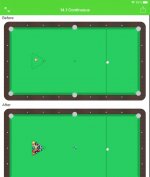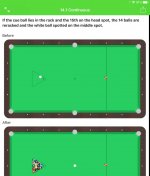L.S. Dennis
Well-known member
Here’s one for all you straight pool aficionados, two end of rack scenarios.
1 at the end of rack, the cue lies on the head spot and the 15th ball lies in the rack.
2 at end of rack 15th ball lies on the head spot, cue lies in the rack, What would say is the correct ruling on placement in these two situations?
These are so rare that they are almost never discussed. I had to dig deep into the BCA rule book to find answers,
Good Luck, as I said just for fun
1 at the end of rack, the cue lies on the head spot and the 15th ball lies in the rack.
2 at end of rack 15th ball lies on the head spot, cue lies in the rack, What would say is the correct ruling on placement in these two situations?
These are so rare that they are almost never discussed. I had to dig deep into the BCA rule book to find answers,
Good Luck, as I said just for fun
Last edited:


